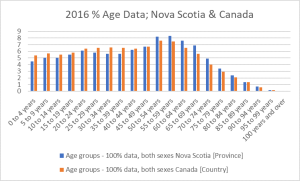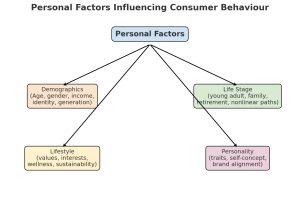Reading: Personal Factors
Reading: Personal Factors
In addition to situational factors, there are also individual traits and characteristics that shape purchasing decisions. These are personal factors such as demographics, life stage, lifestyle, and personality. Understanding these helps marketers design offerings and messages that resonate with target consumers in today’s rapidly shifting environment.
Demographics
Demographics—variables like age, gender identity, income level, education, family structure, and ethnicity—remain a cornerstone of consumer analysis. Each plays a strong role in shaping preferences and decisions.
Generational Cohorts. Marketers continue to examine consumer behaviour across generations, although the focus has shifted from broad generalizations to more nuanced insights.
-
Baby Boomers (1946–1964) are entering or already in retirement, increasingly targeted with products and services related to healthcare, financial security, and leisure. Many also embrace digital technologies for convenience, especially e-commerce and telehealth.
-
Generation X (1965–1980) is known for pragmatism and brand skepticism. They balance careers, aging parents, and teenage/adult children, making them a key market for financial services, travel, and household purchases.
-
Millennials / Gen Y (1981–1996) are highly digital, value authenticity, and often favour experiences over things. Rising housing costs and student debt shape their financial choices. They care about sustainability and brand purpose, rewarding companies with clear ethical stances.
-
Gen Z (1997–2012) are true digital natives. They are highly visual consumers (TikTok, YouTube, Instagram) who prefer personalized, fast, and inclusive experiences. They value diversity, climate action, and mental health awareness, and they expect brands to reflect these priorities.
-
Gen Alpha (2013 onward) are the first generation growing up entirely in a world of tablets, smart speakers, and AI-driven personalization. While still young, they are already influencing household purchases, particularly in entertainment, toys, and food.
Generational differences also play out in media habits: for example, Gen Z gravitates toward TikTok for discovery, while Millennials may rely more on Instagram and podcasts, and Boomers still consume significant amounts of traditional TV.

Graph created from 2016 Census Data Tables. You can view the data on the Statistics Canada website[1]
Gender and Identity. Marketing is moving beyond binary “male vs. female” targeting. Many consumers expect inclusivity in advertising and product design—whether in clothing, personal care, or entertainment. Brands like Nike and Sephora, for example, highlight diversity and gender fluidity in campaigns to align with changing cultural expectations.
Income and Economic Status. Economic realities—such as inflation, job security, or income gaps—strongly shape consumer behaviour. High-income consumers may gravitate toward luxury or premium brands, while middle- and lower-income consumers focus on value, durability, and price transparency. In tough economic times, even affluent consumers “trade down,” seeking private labels or discount retailers. Conversely, accessible luxury brands (like Michael Kors or Apple’s entry-level devices) appeal to aspirational shoppers who want status at a lower price point.
Life Stage
Life stage captures how major events and milestones—rather than just age—shape purchasing behaviour. Moving out, starting a career, getting married, raising children, retirement, or even “empty-nesting” each bring specific needs.
For example:
-
Young adults often prioritize education, fashion, technology, and travel.
-
New parents spend heavily on baby products, childcare, and family-oriented services.
-
Mid-life households may focus on housing, vehicles, education savings, and healthcare.
-
Retirees shift to leisure, health, and financial stability products.
Today, marketers increasingly recognize nonlinear life stages. Many Millennials delay marriage and homeownership, while some Gen Xers return to school mid-career. Brands are adjusting: for instance, banks market flexible student loans to older learners, while travel companies target “skip-gen” vacations (grandparents traveling with grandchildren).
Lifestyle
Lifestyle describes how people live—their daily activities, interests, attitudes, and values—and it’s become one of the most powerful ways to understand consumers. Lifestyle segmentation goes deeper than age or income, capturing how people see themselves and what they aspire to.
Examples include:
-
Eco-conscious consumers seeking sustainable products and brands that demonstrate climate responsibility.
-
Digital nomads investing in portable technology, coworking spaces, and travel-friendly services.
-
Health and wellness seekers prioritizing organic foods, fitness, mindfulness, and mental health resources.
-
Experience-driven consumers spending more on travel, dining, and unique events rather than material goods.
Lifestyle branding has grown stronger in the digital era. Consumers connect with brands that align with their identity—like Patagonia (sustainability and activism), Peloton (fitness and community), or Apple (creativity and design). Social media amplifies this, allowing consumers to express lifestyle affiliations publicly and to expect brands to “walk the talk.”
Personality
Personality refers to the unique traits and characteristics that shape how people interact with the world—and brands. Traits such as confidence, empathy, risk-taking, or introversion can influence what consumers buy and how they buy it.
While personality is difficult to measure directly, marketers often work with the related concept of brand personality. Brands take on human-like qualities—Nike is bold and competitive, Disney is playful and family-friendly, Tesla is innovative and rebellious. Consumers gravitate to brands whose personalities reflect their own values and aspirations, forming strong emotional bonds.
For example, an extroverted consumer may prefer social shopping experiences (like live shopping events or experiential retail), while an introvert may value convenience and anonymity (like subscription boxes or seamless e-commerce).
Increasingly, AI-driven personalization tailors experiences to individual personalities—Netflix recommendations, Spotify playlists, or Amazon’s product suggestions—all based on behavioural cues rather than self-reported traits.

Summary
Personal factors like demographics, life stage, lifestyle, and personality all combine to influence purchasing decisions. Unlike situational factors, these are more deeply tied to identity and long-term behaviour. For marketers, the challenge lies in balancing broad patterns (e.g., generational differences) with personalization at scale, ensuring that each consumer feels seen, understood, and respected.
Creation note: This content was updated with the assistance of ChatGPT, a language model developed by OpenAI, and was subsequently reviewed and edited by the author for clarity and accuracy.
- Data tables, 2016 census. (2018). Statistics Canada. https://www12.statcan.gc.ca/census-recensement/2016/dp-pd/dt-td/Index-eng.cfm ↵

